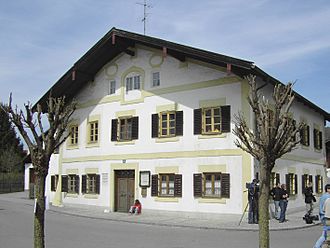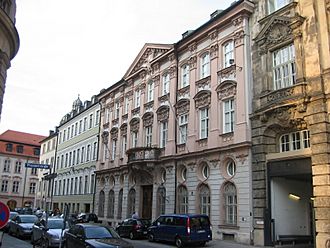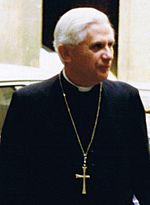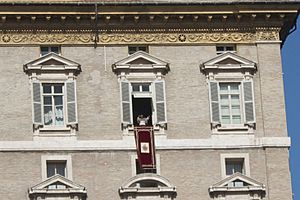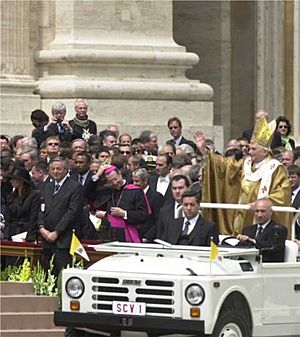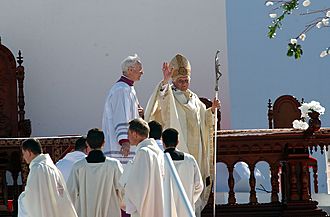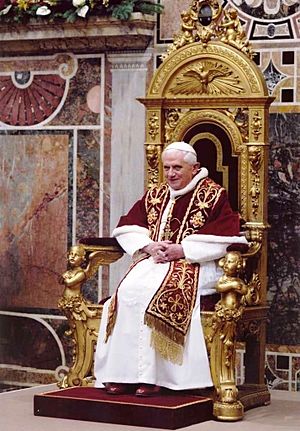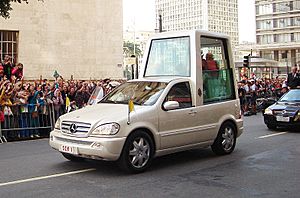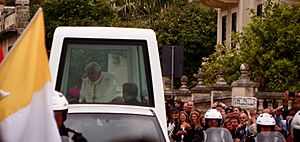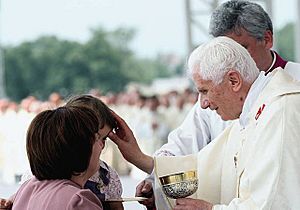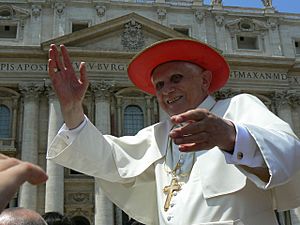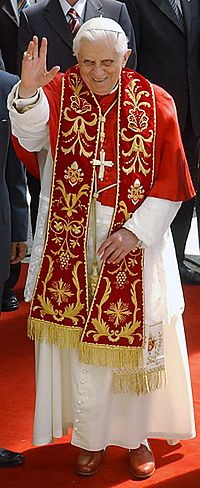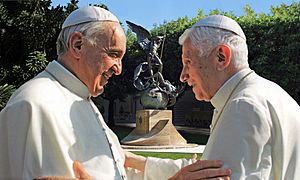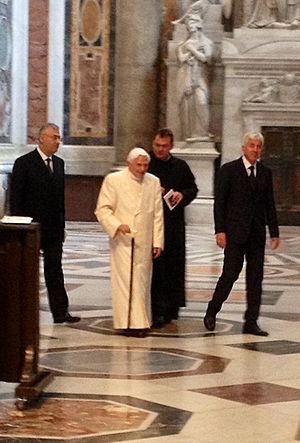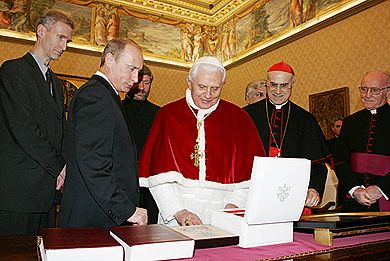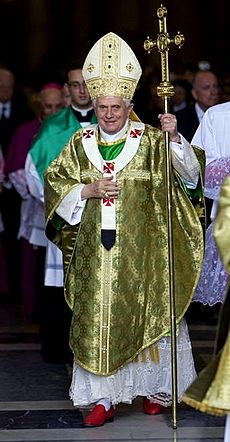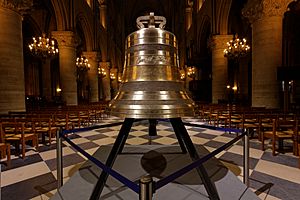Pope Benedict XVI facts for kids
Quick facts for kids Benedict XVI |
|
|---|---|
| Bishop of Rome | |

Benedict XVI in 2011
|
|
| Church | Catholic Church |
| Papacy began | 19 April 2005 |
| Papacy ended | 28 February 2013 |
| Predecessor | John Paul II |
| Successor | Francis |
| Orders | |
| Ordination | 29 June 1951 |
| Consecration | 28 May 1977 by Josef Stangl |
| Created Cardinal | 27 June 1977 |
| Personal details | |
| Birth name | Joseph Aloisius Ratzinger |
| Born | 16 April 1927 Marktl, Bavaria, Germany |
| Died | 31 December 2022 (aged 95) Mater Ecclesiae Monastery, Vatican City |
| Nationality | German |
| Previous post |
|
| Motto | Cooperatores veritatis (Error: {{language with name/for}}: missing language tag or language name (help)) |
| Signature | |
| Coat of arms |  |
| Other Popes named Benedict | |
| Papal styles of Pope Benedict XVI |
|
|---|---|
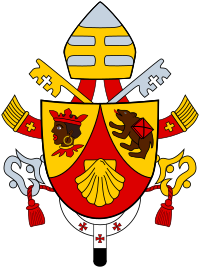 |
|
| Reference style | His Holiness |
| Spoken style | Your Holiness |
| Religious style | Holy Father (2005–2013) Pope Emeritus (2013–2022) |
Pope Benedict XVI (born Joseph Aloisius Ratzinger on 16 April 1927, died 31 December 2022) was the leader of the Catholic Church. He was also the ruler of Vatican City State from 19 April 2005 until he resigned on 28 February 2013. Benedict was chosen as pope after Pope John Paul II passed away. After his resignation, he was known as "pope emeritus".
Joseph Ratzinger became a priest in 1951 in his home region of Bavaria, Germany. He then became a respected theologian (someone who studies religious faith). By 1958, at age 31, he was a full professor. After teaching theology at several German universities, Pope Paul VI made him the Archbishop of Munich and Freising and a cardinal in 1977. This was unusual because he had little experience leading a church. In 1981, he became the Prefect of the Congregation for the Doctrine of the Faith, a very important part of the Roman Curia (the Pope's administration). From 2002 until he became pope, he was also the leader of the College of Cardinals. He was a key figure in the Vatican for 25 years, helping to set the Church's goals as a close advisor to John Paul II. He lived in Rome from 1981 until his death in 2022.
His many writings supported traditional Catholic beliefs and practices. He started as a more liberal theologian but became more conservative after 1968. As pope, Benedict XVI encouraged people to return to basic Christian values. He wanted to fight against the increasing secularization (less religious influence) in many Western countries. He believed that denying objective truth and moral truths was a big problem in the 21st century. He taught that the Catholic Church and understanding God's love were very important. Benedict also brought back some old traditions, like using the Tridentine Mass. He also encouraged the use of Latin and traditional papal vestments (special clothes). People called him "the pope of aesthetics" because of his focus on beauty. He was seen as a major thinker in the Church since the mid-1980s.
On 11 February 2013, Benedict announced he would resign. He said it was because he felt a "lack of strength of mind and body" due to his old age. His resignation was the first by a pope since Pope Gregory XII in 1415. It was also the first time a pope resigned on his own choice since Pope Celestine V in 1294. Pope Francis took over on 13 March 2013. Benedict moved into the Mater Ecclesiae Monastery in Vatican City for his retirement.
Besides German, Benedict could speak French, Italian, English, and Spanish. He also knew Portuguese, Latin, Biblical Hebrew, and Biblical Greek. He was a member of several important groups, like the French Académie des Sciences Morales et Politiques. He played the piano and loved the music of Mozart and Bach.
Contents
- Early Life and Becoming a Priest (1927–1951)
- Life Before Becoming Pope (1951–2005)
- Becoming Pope (2005–2013)
- Pope Emeritus (2013–2022)
- Death and Funeral
- Titles and Styles
- Views on Important Topics
- Interests
- Honors and Awards
- Writings
- See also
Early Life and Becoming a Priest (1927–1951)
Joseph Aloisius Ratzinger was born on 16 April 1927, in Marktl, Bavaria, Germany. He was the youngest of three children. His father, Joseph Ratzinger Sr., was a police officer. His mother was Maria Ratzinger. His older brother, Georg Ratzinger, also became a Catholic priest. His sister, Maria Ratzinger, managed his household until she died in 1991.
When he was five, Joseph was part of a group of children who welcomed the Archbishop of Munich, Michael von Faulhaber. Joseph was so impressed by the cardinal's special clothes that he said he wanted to be a cardinal too. In 1939, at age 12, he joined a minor seminary (a school for boys who want to become priests) in Traunstein. The seminary closed in 1942 for military use, and the students went home.
Wartime and Ordination
Joseph's family did not like the Nazis. His father's opposition led to problems for the family. After his 14th birthday in 1941, Joseph had to join the Hitler Youth because it was required by law. However, he was not enthusiastic and refused to go to meetings. In 1943, he was drafted into the German anti-aircraft corps. Later, he trained in the German infantry. In 1945, as the Allied forces got closer, he left his unit and went home. American troops then set up their headquarters in his family's house. As a German soldier, he was held in a prisoner of war camp but was released a few months later when the war ended in May 1945.
In November 1945, Joseph and his brother Georg entered Saint Michael Seminary. They later studied at the Ludwig-Maximilian University in Munich. Both brothers became priests in Freising on 29 June 1951. Cardinal Michael von Faulhaber, the same man Joseph met as a child, ordained them. Joseph remembered that a little bird sang joyfully when the Archbishop laid his hands on him.
In 1953, Ratzinger wrote his first major paper about Augustine of Hippo. In 1957, he finished another important paper on Bonaventure, which allowed him to become a professor. He became a professor at Freising College in 1958.
Meeting Romano Guardini
In his early twenties, Ratzinger was greatly influenced by Romano Guardini, a German philosopher. Guardini taught in Munich when Ratzinger was studying there. Both thinkers wanted to rediscover the core of Christianity. Guardini wrote The Essence of Christianity in 1938, and Ratzinger wrote Introduction to Christianity three decades later. Guardini inspired many, including the Communion and Liberation movement. Ratzinger wrote an introduction for a 1996 re-release of Guardini's book The Lord.
Life Before Becoming Pope (1951–2005)
Academic Career (1951–1977)
Ratzinger started as a chaplain in Munich in 1951. In 1959, he became a professor at the University of Bonn. He moved to the University of Münster in 1963. During this time, he helped at the Second Vatican Council (1962–1965) as a theological advisor. He was seen as a reformer and worked with other theologians.
In 1966, Ratzinger became a professor at the University of Tübingen. In his 1968 book Introduction to Christianity, he wrote that the pope should listen to different opinions in the Church before making decisions. He also said that the papacy (the Pope's role) was not the only central thing. During this time, he moved away from the student movements of the 1960s, which he saw as moving away from traditional Catholic teachings. Even though he was a reformer, his views started to differ from the more liberal ideas popular in theology. He continued to support the work of the Second Vatican Council, including its documents on respecting other religions and religious freedom.
In 1969, Ratzinger returned to Bavaria, to the University of Regensburg. In 1972, he helped start the theological journal Communio. This journal became very important for Catholic thought. He wrote many articles for it until he became pope. In 1976, he was the Vice President of the University of Regensburg.
Archbishop of Munich and Freising (1977–1982)
On 24 March 1977, Ratzinger was named Archbishop of Munich and Freising. He became a bishop on 28 May. He chose "Cooperators of the Truth" as his motto.
On 27 June 1977, Pope Paul VI made him a Cardinal. By the time of the 2005 papal election, he was one of only 14 cardinals appointed by Paul VI who were still alive.
Prefect of the Congregation for the Doctrine of the Faith (1981–2005)
On 25 November 1981, Pope John Paul II appointed Ratzinger as the Prefect of the Sacred Congregation for the Doctrine of the Faith. This group used to be known as the "Sacred Congregation of the Holy Office". He left his job in Munich in early 1982. He was promoted within the College of Cardinals and became its dean in 2002. Ratzinger joined the European Academy of Sciences and Arts in Salzburg in 1991.
Ratzinger worked to support and confirm Catholic teachings. In 1997, when he turned 70, Ratzinger asked Pope John Paul II if he could retire and work in the Vatican Secret Archives and Vatican Library. However, Pope John Paul II said no.
Becoming Pope (2005–2013)

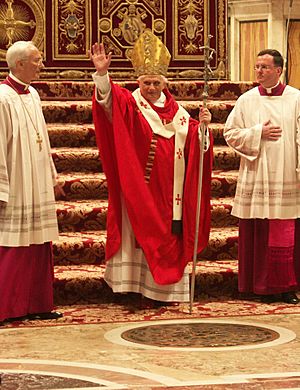
Benedict XVI was elected the 265th pope when he was 78 years old. He was the oldest person to become pope since Pope Clement XII (1730–1740). He served as a cardinal for longer than any pope since Pope Benedict XIII. Benedict and his predecessor, Pope John Paul II, were the first two popes in a row who were not Italian since the 1300s. The last pope named Benedict was Pope Benedict XV, who was pope from 1914 to 1922.
In January 2005, Time magazine said that Ratzinger was a top candidate to become the next pope. After John Paul II died, the Financial Times also saw Ratzinger as a strong possibility. In April 2005, before he was elected, Time named him one of the 100 most influential people in the world. As Prefect, Ratzinger had often said he wanted to retire to his home in Bavaria and write books.
At the conclave (the meeting where cardinals elect a new pope), Ratzinger was elected on 19 April 2005, after four rounds of voting. Cardinal Cormac Murphy-O'Connor described the voting as very serious. Ratzinger himself said he prayed to God "please don't do this to me," but God "didn't listen." Before he appeared on the balcony of St. Peter's Basilica, Cardinal Jorge Medina announced him.
Benedict's first words to the crowd were in Italian:
Dear brothers and sisters, after the great Pope John Paul II, the Cardinals have elected me, a simple, humble labourer in the vineyard of the Lord. The fact that the Lord knows how to work and to act even with insufficient instruments comforts me, and above all I entrust myself to your prayers. In the joy of the Risen Lord, confident of his unfailing help, let us move forward. The Lord will help us, and Mary, His Most Holy Mother, will be on our side. Thank you.
On 24 April, he celebrated his first Mass as pope in St. Peter's Square. On 7 May, he officially took over his main church, the Archbasilica of St. John Lateran.
Choosing His Papal Name
Ratzinger chose the name Benedict, which means "the blessed" in Latin. He chose it to honor both Pope Benedict XV and Benedict of Nursia. Benedict XV was pope during World War I and worked hard for peace. Saint Benedict of Nursia started the Benedictine monasteries and wrote the Rule of Saint Benedict, which guided monastic life. The Pope explained his choice on 27 April 2005:
Filled with sentiments of awe and thanksgiving, I wish to speak of why I chose the name Benedict. Firstly, I remember Pope Benedict XV, that courageous prophet of peace, who guided the Church through turbulent times of war. In his footsteps I place my ministry in the service of reconciliation and harmony between peoples. Additionally, I recall Saint Benedict of Nursia, co-patron of Europe, whose life evokes the Christian roots of Europe. I ask him to help us all to hold firm to the centrality of Christ in our Christian life: May Christ always take first place in our thoughts and actions!
His Papacy's Style
During his first Mass as pope, the tradition of every cardinal bowing to the Pope was changed. Instead, twelve people, including cardinals, priests, a married couple, and newly confirmed people, greeted him. He started using an open-topped papal car because he wanted to be closer to people. Benedict continued the tradition of baptizing babies in the Sistine Chapel at the start of each year.
Beatifications
On 9 May 2005, Benedict XVI started the process to make his predecessor, Pope John Paul II, a saint. Usually, five years must pass after a person's death before this process can begin. However, due to "exceptional circumstances," this rule was waived. This had happened before for Popes Pope Pius XII and Pope John XXIII. The decision was announced on 13 May 2005, a special day for Our Lady of Fátima, whom John Paul II credited with saving his life.
Benedict XVI changed the process for beatifications. From 29 September 2005, beatifications were usually celebrated by a representative of the pope, not the pope himself.
Canonizations
During his time as Pope, Benedict XVI made 45 people saints. His first canonizations were on 23 October 2005. He made five people saints, including Alberto Hurtado. In 2007, during his visit to Brazil, he made Frei Galvão a saint. On 3 June 2007, he made George Preca a saint, who was the first Maltese saint since 60 A.D.
On 19 September 2010, during his visit to the United Kingdom, Benedict personally made John Henry Newman a saint.
Doctors of the Church
On 7 October 2012, Benedict XVI named Hildegard of Bingen and John of Ávila "Doctors of the Church". These are special titles given to saints who have made important contributions to theology. They were the 34th and 35th people to receive this honor.
Church Administration Changes
Benedict made only small changes to the way the Roman Curia (the Pope's administration) was organized. In March 2006, he put two councils, one for migrants and one for justice and peace, under one leader. Later, in May 2007, the Pontifical Council for Interreligious Dialogue was restored to its separate status. In June 2010, Benedict created a new group called the Pontifical Council for the Promotion of the New Evangelisation.
Key Teachings
As pope, one of Benedict XVI's main jobs was to teach about the Catholic faith. He focused on helping people understand and live their faith.
"Friendship with Jesus Christ"
Benedict often spoke about the importance of "friendship with Jesus Christ." He said that everything depends on this close friendship. He encouraged people to talk to God like a friend, saying that God is the only one who can make the world good and happy. In his book Jesus of Nazareth, he aimed to help readers grow their relationship with Jesus.
He also wrote about this in his first encyclical, Deus caritas est. He explained that if friendship with God becomes more important, people will start to love those God loves and those who need help. He said that prayer is very important, especially when people are busy and becoming less religious.
"Dictatorship of Relativism"
Benedict often talked about what he called the "dictatorship of relativism." On 6 June 2005, he said that this idea, which believes nothing is truly right or wrong, leaves people with only their own desires as a guide. He believed this could trap people and separate them from each other.
He said that denying objective truth, especially moral truths, was the main challenge for the Church and humanity. He linked this to problems in religion, like terrorism, and problems in science, like ecological disasters. He believed that making something relative into an absolute rule leads to totalitarianism (a government that controls everything).
Christianity as a Religion of Reason
Benedict also discussed Christianity as a "Religion of the Logos" (meaning "reason" or "intelligence"). He said that Christianity has always seen itself as based on reason. He believed that the Age of Enlightenment, which emphasized reason, came from Christian ideas. He said that Christians should live their faith based on reason and be open to all that is truly rational.
Encyclicals
Benedict wrote three encyclicals (important letters from the Pope): Deus caritas est ("God is Love"), Spe Salvi ("Saved by Hope"), and Caritas in veritate ("Love in Truth"). In Deus caritas est, he wrote that humans, made in God's image, can practice love by giving themselves to God and others. He said this life of love is like the lives of saints such as Mother Teresa.
His second encyclical, Spe Salvi, was about the importance of hope. His third, Caritas in veritate, was about social justice. In it, he criticized the current economic system and called for ethics in business.
When he resigned, Benedict had almost finished a fourth encyclical, Lumen fidei ("The Light of Faith"). This was meant to complete a series on the three theological virtues of faith, hope, and love. His successor, Pope Francis, finished and published Lumen Fidei in June 2013.
Apostolic Exhortation
Sacramentum caritatis (The Sacrament of Charity), signed on 22 February 2007, was a document that summarized ideas from a meeting of bishops held in 2006.
Tridentine Mass
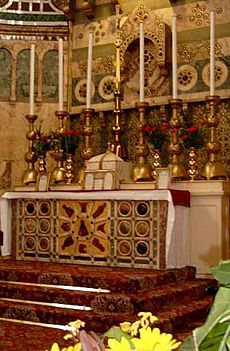
On 7 July 2007, Benedict XVI issued a document called Summorum Pontificum. This document made it easier to celebrate Mass using the Missal of 1962 (also known as the Tridentine Mass). He said that groups of people who wanted this Mass could now simply ask their local priest for permission. He also allowed any qualified priest to offer private celebrations of this Mass.
In a letter, the Pope explained his decision. He said that the Tridentine Mass would not take away from the Second Vatican Council and that the Mass of Paul VI would still be the usual way to celebrate Mass. He also said that the Tridentine Mass "was never legally cancelled" and was always allowed. He believed that allowing the Tridentine Mass could help prevent or heal divisions in the Church.
In July 2021, Pope Francis changed this decision with a new document called Traditionis custodes. This document put new limits on using the Traditional Latin Mass.
Catholic Church's Unique Role
In June 2007, the Congregation for the Doctrine of the Faith released a document approved by Benedict XVI. This document clarified the Catholic Church's position on its unique role in salvation. It was seen as restating parts of a 2000 document Benedict wrote when he was Prefect, Dominus Iesus.
Consumerism
Benedict XVI spoke against too much consumerism, especially among young people. In June 2009, he said that outsourcing (sending jobs to other countries) led to more consumer goods but also to cuts in social security systems.
Working with Other Religions and Groups
Other Christian Groups
On 7 June 2006, Benedict said that Jesus had given the leadership of the Church to Peter. He prayed that the Pope's role, given to human beings, would always be used as Jesus intended.
In 2006, Benedict met Rowan Williams, the Archbishop of Canterbury (the leader of the Anglican Communion). They talked about the dialogue between Catholics and Anglicans but also noted "serious obstacles" to their unity. Benedict also recognized the Lutheran church.
In 2009, Benedict created "Personal Ordinariates" for Anglicans who wanted to become full members of the Catholic Church.
Judaism
When Benedict became Pope, his election was welcomed by the Anti-Defamation League. They noted his "great sensitivity to Jewish history and the Holocaust". However, the Chief Rabbi of the United Kingdom hoped Benedict would continue to improve relations with Jewish people.
Some critics said Benedict's papacy was not sensitive enough towards Judaism. This was mainly because he expanded the use of the Tridentine Mass, which includes a prayer that some found problematic. Also, he lifted the excommunication of four bishops from the Society of Saint Pius X (SSPX), one of whom was accused of denying the Holocaust.
Islam
Benedict's relationship with Islam was sometimes difficult. On 12 September 2006, he gave a lecture in Germany that mentioned Islam. Many Islamic leaders protested, saying he had insulted Islam. They were especially offended by a quote he used from a Byzantine emperor, which spoke harshly about Muhammad.
Benedict apologized for any offense he caused. He then visited Turkey, a Muslim country, and prayed in the Blue Mosque. He also met with Muslim scholars in Rome in 2008. In May 2009, Benedict visited the King Hussein Mosque in Amman, Jordan.
Tibetan Buddhism
The 14th Dalai Lama congratulated Benedict XVI on his election and visited him in the Vatican in October 2006.
Indigenous American Beliefs
During a visit to Brazil in May 2007, the Pope caused some controversy. He said that native people had "silently longed" for the Christian faith brought by colonizers. He also said that the spread of Jesus's message did not involve taking away pre-Columbus cultures. The President of Venezuela, Hugo Chávez, demanded an apology. Later, the Pope said it was "not possible to forget the suffering and the injustices" caused by colonizers, but he did not apologize.
Hinduism
On 17 April 2008, during his visit to the United States, Benedict met with a representative of the International Society for Krishna Consciousness. He received a gift of an Om symbol from the Hindu American community.
Papal Journeys and Activities
Benedict traveled a lot during his first three years as pope. He visited his home country, Germany, twice. He also went to Poland and Spain, where he was warmly welcomed. His visit to Turkey, a mostly Muslim country, was difficult at first because of a lecture he had given. However, the trip went well, and Benedict made a joint statement with Ecumenical Patriarch Bartholomew I to try to improve relations between Catholic and Orthodox churches.
In 2007, Benedict visited Brazil to speak to bishops and make a friar named Antônio Galvão a saint. In June 2007, he made a special visit to Assisi, the birthplace of St. Francis. In September, he visited Austria, where he joined Vienna's Chief Rabbi in remembering the Jews who died in Nazi camps.
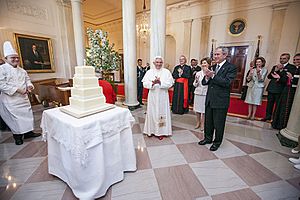
In April 2008, Benedict XVI made his first visit to the United States as pope. He met with U.S. President George W. Bush at the White House. In Washington, he spoke to Catholic university representatives, met with leaders of other religions, and celebrated Mass for 47,000 people. He then traveled to New York, where he spoke at the United Nations General Assembly. He also celebrated Mass at St. Patrick's Cathedral, met with children with disabilities, and spoke to 25,000 young people. On his last day, he visited the World Trade Center site and celebrated Mass at Yankee Stadium.
In July 2008, the Pope went to Australia for World Youth Day 2008. In September 2008, at a Mass in Paris, Benedict XVI spoke against modern materialism (love of power, possessions, and money), calling it a "modern-day plague." In 2009, he visited Africa and the Middle East for the first time as pope.
Most of Benedict's activities happened in the Vatican. He gave his Christmas and Easter speeches from St Peter's Basilica. Even in the Vatican, there were some security incidents. In 2007, a man tried to jump onto his vehicle. In 2009, a woman pulled him to the ground during Christmas Eve Mass. He fell but continued the Mass.
In his speech, Benedict forgave the woman and asked the world to "wake up" from selfishness and focus on God.
In April 2010, Benedict visited Malta. He met with leaders and celebrated Mass for 50,000 people. He also met with about 10,000 young people.
Papal Clothing
Benedict XVI brought back some traditional papal garments (clothes) that had not been used for a while. He started wearing the traditional red papal shoes, which popes had used since Roman times. The Vatican said his personal shoemaker made them.
On one occasion, in December 2005, the Pope wore the camauro, a traditional red papal hat for winter. It had not been seen since Pope John XXIII (1958–1963). In September 2006, the Pope started wearing the red cappello romano (a wide-brimmed hat for outdoors).
A journalist described Benedict as "the pope of aesthetics" because he reminded the world about beauty in music, art, and clothing.
His Health
Before becoming pope in 2005, Ratzinger wanted to retire because of his age and a desire to write. He offered to resign three times, but Pope John Paul II asked him to stay. In 1991, Ratzinger had a mild stroke that temporarily affected his eyesight, but he fully recovered. This was not officially announced but was known to the cardinals who elected him.
After he became pope, there were rumors about his health, but none were confirmed. In May 2005, the Vatican said he had another mild stroke. A French Cardinal said Ratzinger had a heart condition related to his age and was taking medication for it.
On 17 July 2009, Benedict broke his right wrist after falling while on vacation. His injuries were minor.
After he announced his resignation, the Vatican revealed that Benedict had a pacemaker implanted before he became pope in 2005. The battery had been replaced three months earlier, which was a routine procedure and did not affect his decision to resign.
Resignation from Papacy

On 11 February 2013, the Vatican confirmed that Benedict XVI would resign as pope on 28 February 2013. He said it was due to his old age. He was the first pope to resign since Pope Gregory XII in 1415. At 85 years old, he was the fourth-oldest pope to hold the office. This decision was unexpected because modern popes usually serve until they die. Benedict was the first pope to resign without outside pressure since Pope Celestine V in 1294.
In his statement, Benedict said his strength was decreasing, and the papacy required a lot of physical and mental energy. He told his cardinals in Latin that he would continue to serve the Church through prayer.
The Vatican said the timing of his resignation was not due to a specific illness but to avoid the busy Easter schedule. After two weeks of farewells, the Pope left office, and a period called sede vacante (when the papal seat is empty) began.
A year after his resignation, Benedict wrote to an Italian newspaper to say that he was not forced to step down. He said his decision was made with "full freedom" and that any talk of it being invalid was "absurd." In 2021, he again confirmed the legitimacy of his resignation.
Pope Emeritus (2013–2022)
On the morning of 28 February 2013, Benedict met with the College of Cardinals. In the afternoon, he flew by helicopter to the papal summer home, Castel Gandolfo. He stayed there until his retirement home, the Mater Ecclesiae Monastery in the Vatican Gardens, was ready. He moved there on 2 May 2013. The monastery has a large garden and is near Vatican Radio.
After resigning, Benedict XVI kept his papal name instead of going back to his birth name. He continued to wear the white cassock (a long robe) but without some of the special papal clothing. He stopped wearing red papal shoes. Benedict returned his official Fisherman's Ring, which was then made unusable.
A Vatican spokesman said Benedict spent his first day as pope emeritus with Archbishop Georg Gänswein, his private secretary. In the monastery, the pope emeritus studied and wrote. He joined his successor, Pope Francis, at the unveiling of a new statue of Saint Michael the Archangel. The statue has the coats of arms of both popes, showing that Benedict XVI ordered it and Francis blessed it.
In 2013, there were reports that Benedict had health problems, but the Vatican denied any specific illnesses.
Benedict XVI made his first public appearance after resigning on 22 February 2014, at St. Peter's Basilica. He attended a meeting of cardinals led by Pope Francis. He also attended the Mass where Pope John XXIII and Pope John Paul II were made saints.
In August 2014, Benedict XVI celebrated Mass at the Vatican and met with his former students, a tradition he had kept since the 1970s. He attended the beatification of Pope Paul VI in October 2014. Before this, he joined Francis in Saint Peter's Square for a meeting with grandparents.
In March 2016, Benedict gave an interview about mercy and supported Francis's focus on it. A Vatican spokesman said that Benedict's physical health was "slowly, serenely fading," but his mind was still "perfectly clear."
In November 2017, pictures showed Benedict with a black eye. He had slipped earlier and gotten a bruise.
In late 2019, Benedict worked on a book about the Catholic Church's rule that priests should not marry. However, he later asked for his name to be removed as co-author.
In June 2020, Benedict visited his dying brother Georg in Germany for the last time. Georg died on 1 July at age 96.
In August 2020, his helpers said he had an inflammation of a nerve in his face. In December 2020, a cardinal said Benedict had trouble speaking and had told new cardinals that "the Lord has taken away my speech in order to let me appreciate silence."
Benedict became the longest-lived pope on 4 September 2020, at 93 years, 4 months, and 16 days old, passing Pope Leo XIII.
In January 2021, Benedict and Francis both received COVID-19 vaccines. On 29 June 2021, he celebrated 70 years as a priest.
After a meeting of cardinals in August 2022, Pope Francis and the new cardinals visited Benedict at Mater Ecclesiae Monastery.
Death and Funeral
Worsening Health and Death
On 28 December 2022, Pope Francis said that Benedict was "very sick" and asked for prayers. The same day, the Vatican said Benedict's health was getting worse due to his old age and that he was under medical care. Francis visited Benedict at the Mater Ecclesiae monastery.
Benedict died on 31 December 2022, at 9:34 AM Central European Time, at his home in the Vatican. He was 95 years old.
Funeral Plans
From 2 January 2023, his body lay in state in St. Peter's Basilica. His funeral took place on 5 January 2023, in St. Peter's Square at 9:30 AM, led by Pope Francis.
Titles and Styles
As Pope, his full title was:
His Holiness Benedict XVI, Bishop of Rome, Vicar of Jesus Christ, Successor of the Prince of the Apostles, Supreme Pontiff of the Universal Church, Primate of Italy, Archbishop and Metropolitan of the Roman Province, Sovereign of the Vatican City State, Servant of the servants of God.
The most common title, "Pope," was not in the official list but was used in documents and signatures.
Before 1 March 2006, the list of titles also included "Patriarch of the West." This title was removed in 2006 as a "sign of ecumenical sensitivity" (to show openness to other Christian groups).
After his resignation, the official style for the former Pope in English was His Holiness Benedict XVI, Supreme Pontiff Emeritus or Pope Emeritus. He was also called Emeritus Pope or Roman Pontifex Emeritus. He preferred to be known simply as "Father."
Views on Important Topics
HIV/AIDS
In 2005, the pope suggested ways to fight the spread of HIV, including being pure, faithful in marriage, and working to end poverty.
International Relations
Migrants and Refugees
In November 2006, the Pope asked for international agreements and policies to protect all migrants, including refugees and displaced people. He said the Church supports efforts to defend their rights. He also encouraged Catholic groups to help them.
In 2015, it was reported that Benedict was "praying for migrants and refugees" from Syria.
China
In 2007, Benedict sent a letter to Catholics in China. This letter gave guidance to Chinese bishops on how to work with the government and strengthen ties with the Chinese Patriotic Catholic Association.
Korea
In November 2006, Benedict said that the issue of North Korea's nuclear weapons program should be solved through talks. He believed the solution should be peaceful and respect agreements to make the Korean Peninsula nuclear-free.
Turkey
In a 2004 interview, Ratzinger said that Turkey, a Muslim country, should look to join a group of Muslim nations rather than the European Union, which he said has Christian roots. He believed linking Turkey to Europe would be a mistake.
Later, when he visited Turkey, it was reported that he supported Turkey's bid to join the EU. However, a joint statement with Patriarch Bartholomew I of Constantinople suggested that support for Turkey's EU membership would depend on religious freedom in Turkey.
Israel
In May 2009, he visited Israel. This was the third time a pope had visited the Holy Land.
Vietnam
Benedict XVI met with the Prime Minister of Vietnam in 2007 and the President in 2009. Vatican officials called these meetings "a significant step" in improving relations with Vietnam.
Global Economy
In July 2009, Benedict XVI published his third encyclical, Caritas in veritate (Charity in Truth). This document discussed the moral foundations for human development and working for the common good. It was his last encyclical as pope.
Caritas in veritate talked about sharing wealth fairly, the environment, migration, terrorism, and energy. The Financial Times said Benedict XVI's ideas helped set the agenda for the 2009 G8 summit.
The encyclical also suggested allowing citizens to decide how to use a part of their taxes to help others.
Nuclear Energy
Benedict XVI called for nuclear disarmament (getting rid of nuclear weapons). At the same time, he supported the peaceful use of nuclear energy to help development and fight poverty. He confirmed the Holy See's support for the International Atomic Energy Agency.
Interests
Benedict loved classical music and was a talented pianist. His favorite composer was Wolfgang Amadeus Mozart, whose music he said "contains the whole tragedy of human existence." Benedict also said Mozart's music deeply affected him as a young man. His favorite pieces were Mozart's Clarinet Concerto and Clarinet Quintet. He even recorded an album where he sang and recited prayers to the Blessed Virgin Mary.
Benedict was also known to love cats. As Cardinal Ratzinger, he was known to care for stray cats in his neighborhood. A book called Joseph and Chico: A Cat Recounts the Life of Pope Benedict XVI was published in 2007. It told the story of the Pope's life from the perspective of a cat. During his trip to Australia in 2008, organizers lent the Pope a grey cat named Bella to keep him company.
Social Media
In December 2012, the Vatican announced that Benedict XVI had joined Twitter with the username @Pontifex. His first tweet on 12 December was: "Dear friends, I am pleased to get in touch with you through Twitter. Thank you for your generous response. I bless all of you from my heart." On 28 February 2013, the day he retired, his tweets were saved, and @Pontifex read "Sede Vacante" (meaning the papal seat was empty). Pope Francis took over the @Pontifex account after his election.
Honors and Awards
- 2005 Grand Master of the Order of Malta
- 2010 honorary citizen of Romano Canavese, Italy
- 2010 honorary citizen of Lisbon, Portugal
- The asteroid 8661 Ratzinger was named in his honor. This was because of his role in opening Vatican archives in 1998 for research into mistakes made against Galileo and other scientists.
- Coat of Arms
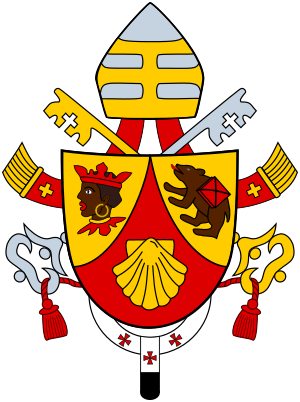 |
|
Writings
Benedict XVI wrote 66 books, three encyclicals, and four apostolic exhortations.
See also
 In Spanish: Benedicto XVI para niños
In Spanish: Benedicto XVI para niños
- Cardinals created by Benedict XVI
- Papal regalia and insignia – papal attire
- Three Secrets of Fátima – document on the release of the Third Secret of Fátima


